The Catholic University Leuven in Belgium is a haunted place. It is haunted not by a ghost, not by a vampire, but by a Zombie Scientist: Catherine Verfaillie, director of the Stem Cell Institute (SCIL) at the KU Leuven. Verfaillie’s infamous discovery was that of the alleged pluripotency of bone marrow cells, for which she was celebrated by everyone including the Catholic Church. Adult stem cells in the blood can create every tissue, exactly like the ethically problematic embryonic stem cells. The clinical potential for lab-grown organs was immediately obvious. Verfaillie became a star, Nobel Prize was all but sure. Now it’s time for exorcism, with the help of non other but Elisabeth Bik.
Even if her findings were debunked right after they appeared in Nature in 2002, the damage is still continuing. Clinical researchers used Verfaillie’s “discovery” as basis to test outrageously brain-dead and dangerous regenerative medicine ideas, where bone marrow cells are extracted form the patient and deployed to repair or even create organs. In particular, the surgeons Paolo Macchiarini and Martin Birchall applied bone marrow “stem cell” woo to test lab-grown tracheas on over 20 human guinea pigs. Almost every one of these patients died, but the experiments continue.
Verfaillie was even put on a stamp in her home county, so every Belgian had the opportunity to lick her behind. Despite the many data manipulations and the fact that her research was debunked long ago, Verfaillie was never found guilty of any research misconduct by her former employer, the University of Minnesota in USA. In fact, it seems Macchiarini’s & Birchall’s pioneering trachea transplant in 2008 might have saved her career: it namely proved that even if Verfaillie’s discovery of bone marrow pluripotency was based of falsified data, it was scientifically perfectly sound! Look, a whole trachea was grown in a lab to save the life of a young woman, just when Verfaillie was investigated for research misconduct. Only that that trachea transplant was the first big lie in a long string of lies, which left many patients dead. And there were and still are also many other bone marrow regmed enthusiasts, with their own countless victims. This carnage is the legacy of Verfaillie’s dishonest preclinical research.
She is still being paraded as Belgium’s greatest scientist and showered in funding cash: after the initial €5mn grant in 2011, Verfaillie became in 2015 project head of a €10 mn Consortium “Hepatic Microfluidic Bioreactor”, funded by the EU Commission, making artificial livers. In 2016, Verfaillie was part of the team awarded with €11.5 mn by EU to study Zika virus. Apparently, Verfaillie’s Photoshop skills are needed there. And in summer 2019, Verfaillie and her SCIL got €2.9 mn from Flanders Innovation and Entrepreneurship to collaboratate with a pharma company in designing therapies for myelin-related neurological diseases. There is truly nothing Photoshop cannot cure.
In February 2013, Verfaillie congratulated Macchiarini to his announced plastic trachea transplant on the 2-year-old patient (who died just 8 weeks after the operation):
“Creating a windpipe out of the blue is certainly a major event,” says Verfaillie on the phone. “The evolution has been going fast in recent years. Techniques have been developed to make tissues by implanting stem cells on all kinds of constructs. But the effective applications are still rare. Apart from the windpipe and the bladder [reference to Anthony Atala’s bizarre experiment, -LS], which are both simple organs, I don’t see much coming yet. ”
The article went on to describe Verfaillie’s own stem cell research where she aimed to use her freshly awarded EU grant to treat “patients with gangrene in the lower leg”.
Just this year, in spring 2019, Verfaillie was recruited by the Belgian MEP Petra De Sutter (gynaecologist and stem cell enthusiast) as a list candidate for European Greens to the EU Parliament. On that occasion, the Belgian newspaper De Morgen celebrated again Verfaillie’s discovery of pluripotent bone marrow cells and declared:
“Verfaillie’s work was the basis of hundreds of publications and a Nobel Prize.”
Also this was not meant ironically – Verfaillie’s programme for the EU is research integrity, as she herself explained on De Sutter’s website:
“Only if there is room for independent research, with integrity and quality going hand in hand. Biomedical research funded by European public funds must serve the public interest in the first place“.
Incidentally, the biggest critic of Macchiarini’s and Birchall’s stem cell experiments was another KU Leuven professor: the surgeon Pierre Delaere, but he doesn’t get the publicity his genius colleague Verfaillie enjoys. KU Leuven eventually had Delaere silenced, maybe they wanted to divert attention from their own role in making the Macchiarini disaster possible.
Instead of fixing what they started, KU Leuven prefers to hold image integrity events (like this one on 12 December 2019), where Verfaillie most definitely never be mentioned. As my distant, unsolicited and unwelcome contribution, I asked the famous image Integrity sleuth Elisabeth Bik to have a look at Verfaillie’s papers. Bik kindly agreed, below are some of her discoveries, more is on Pubpeer.
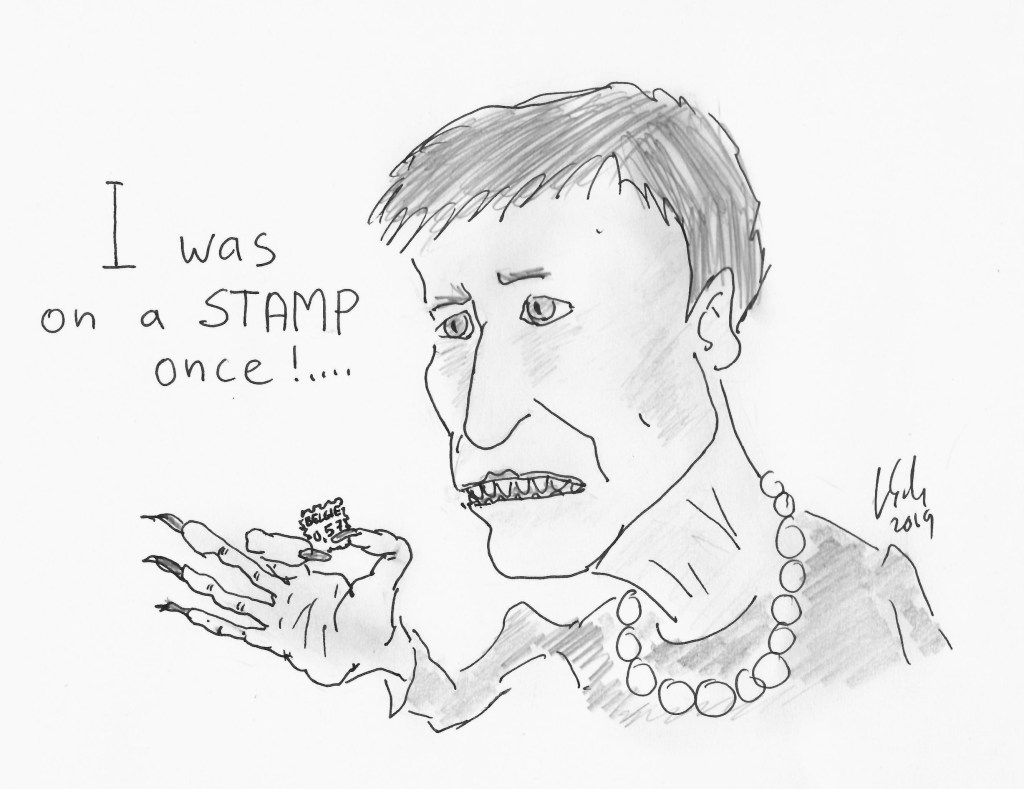
This was the disastrous Nature paper which set in motion the deadly bone marrow quackery worldwide:
Y Jiang, BN Jahagirdar, RL Reinhardt, RE Schwartz, CD Keene, XR Ortiz-Gonzalez, M Reyes, T Lenvik, T Lund, M Blackstad, Ji Du, S Aldrich, A Lisberg, WC Low, DA Largaespada, CM Verfaillie Pluripotency of mesenchymal stem cells derived from adult marrow Nature (2002) – doi: 10.1038/nature00870
In June 2007, the paper received a mega-correction. Elisabeth Bik now commented on PubPeer:
“In summary the following errors were found and corrected:
- In Figure 1b, the IgG isotype control tracings for several of the plots (n=5) differ by 1 log in fluorescence intensity; a new version of Figure 1b are provided but for a different set of MAPC cells
- in the original Fig. 1b, the plot for MHC I was a duplication of the FACS plot for Mac-1
- In the legend to Fig. 1b, the superscripts ‘k’ in MHC II (I-Ak) and MHC I (H- 2Kk) should be ‘b’.
- In the Methods under ‘Differentiation culture and analysis’, the concentration of 109 M dexamethasone should be 0.05 mM.
- In the Supplementary Information, the sequence of the primers rex-1 and oct-4 were incorrect; correct sequences are provided.
However, what the Correction does not address is that six of the panels in Figures 1b and S1b from this Nature paper are also shown in a second paper by the same group, i.e. Yuehua Jiang et al. Experimental Hematology 30 (2002) 896–904, DOI: 10.1016/s0301-472x(02)00869-x. See: https://pubpeer.com/publications/9F0F20DFB792B0606731DB6E20C3CE Although this Nature paper was published before the Exp Hem paper, the Exp Hem manuscript was submitted and accepted earlier than the Nature paper.
The six panels duplicated between the two papers represent different MAPC cell lines, as can be learned from the Erratum belonging to the Exp Hematology paper, found at: https://www.exphem.org/article/S0301-472X(06)00305-5/abstract. “
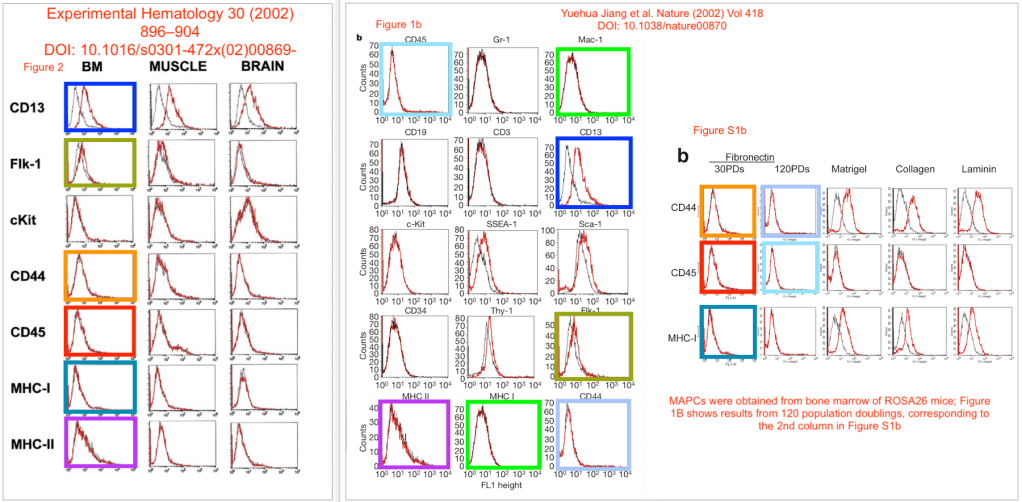
And then Bik found another new problem, somehow ignored in that mega-corrected Nature paper. It is the same image, but showing different mice (control vs chimeric) and different antibody stainings, with the green signal removed in one case. In order to produce some result Verfaillie needed to prove her ground-breaking discovery:
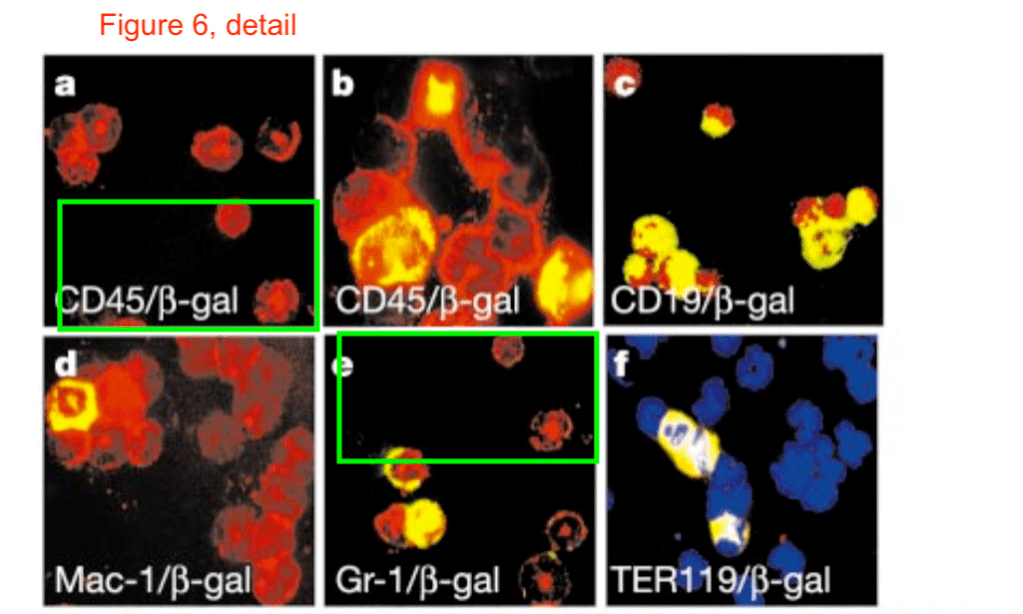
Also Figure 6m shows traces of Photoshop manipulation: the repetitive patterns suggest an undesired feature was retouched:
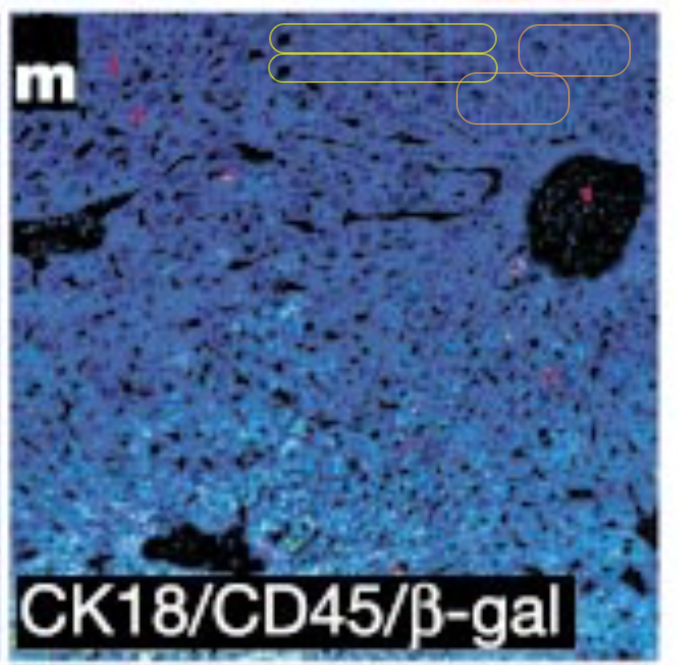
That 2002 Nature opus was suspicious from the very beginning. Nobody could reproduce Verfaillie’s results, while she prevented her peers from accessing the allegedly pluripotent bone cells which only her lab was able to extract from mice.
Maybe that Nature paper should be retracted after all? Especially considering how much damage it still keeps doing? Or will Verfaillie and Macchiarini eventually share a joint Nobel Prize?
In March 2009, Verfaillie had the following infamous retraction, initiated by the University of Minnesota in October 2008. This 2001 Blood paper was the precursor to Nature‘s pluripotency claims and served to establish bone marrow cells as a magic source to grow all organs.
M Reyes, T Lund, T Lenvik, D Aguiar, L Koodie, CM Verfaillie Purification and ex vivo expansion of postnatal human marrow mesodermal progenitor cells Blood (2001) doi: 10.1182/blood.v98.9.2615
The retraction notice was unspecific, just saying:
“Based upon the conclusions of the investigation by the University of Minnesota and Blood, the paper was found to contain duplications and other irregularities in multiple figures.”
The first author Morayma Reyes was assigned the entire blame, as Nature reported:
“Lead author Catherine Verfaillie, now director of the Stem Cell Institute at the Catholic University of Leuven in Belgium, was cleared of academic misconduct but blamed for insufficient oversight. That suggests the blame rests with the only other scientist under investigation, Verfaillie’s graduate student Morayma Reyes, now at the University of Washington. However, the findings regarding Reyes cannot be released because of privacy laws. Reyes says that she made “honest unintentional errors”.
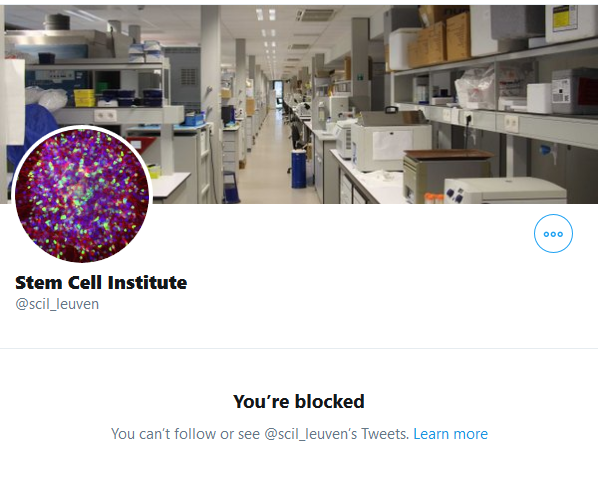
Verfaillie again fingered Reyes, even for the papers where Reyes was not coauthor, and declared herself a victim:
“The University indeed concluded that another individual working in my lab committed academic misconduct by improperly manipulating western blots in the Blood paper. Although the University Panel did not conclude that the conclusions of the paper are invalid, it has requested that the Blood paper be retracted.
The University concluded that allegations against me personally were not substantiated, and that I was not responsible for the alleged manipulations. Nevertheless, I am extremely sorry about this, as I was the senior author on the paper and did not notice the problems with these figures. The University’s statement also concluded that I did not provide sufficient oversight and mentoring. I do not agree with the University’s conclusion with regard to the question of oversight and mentoring.
I am committed to honesty in the pursuit of science. The methods that were followed in my lab at the time of the research in question were, and still are, common practice in the scientific community.”
Verfaillie is actually right. Data forgery is indeed common practice in the scientific community, and this was exactly what many regenerative medicine researchers do, while building on Verfaillie’s work.
Faced with a cryptic retraction notice, Bik performed a “Post mortem analysis” of that Blood paper, and found fake western blots and some Flaw Cytometry:
Another Verfaillie paper was retracted in same year 2009, there is no Reyes on it:

J Lin, Feng, Y Hamajima, M Komori, TC Burns, S Fukudome, J Anderson, D Wang , CM Verfaillie, WC Low Directed differentiation of mouse cochlear neural progenitors in vitro AJP Cell Physiology (2009) doi: 10.1152/ajpcell.00324.2008
The notice went:
“This article has been retracted by APS on the grounds that aspects of the data presented have now been shown to be unreliable.”
As Bik discovered, something was very, very wrong with Figure 3B. Who was responsible for that sickening parade of copy-pasted bands? Surely not the Belgian genius scientist Verfaillie? I mean, they just tried to use stem cell technology to cure deafness, and surely the Photoshop means justify the goal, right?
Bik also analysed this 2002 paper by Verfaillie, corrected in November 2008 for some unspecified errors with certain figures. The University of Minnesota decided there was definitely no research misconduct there, just some “problematic images”. The paper claimed to have discovered that bone marrow cells can generate vascular endothelium, a scientifically very shaky claim which had to be substantiated by some Flaw Cytometry:
M Reyes, A Dudek, B Jahagirdar, L Koodie, PH Marker, CM Verfaillie Origin of endothelial progenitors in human postnatal bone marrow Journal of Clinical Investigation (2002) doi: 10.1172/jci200214327
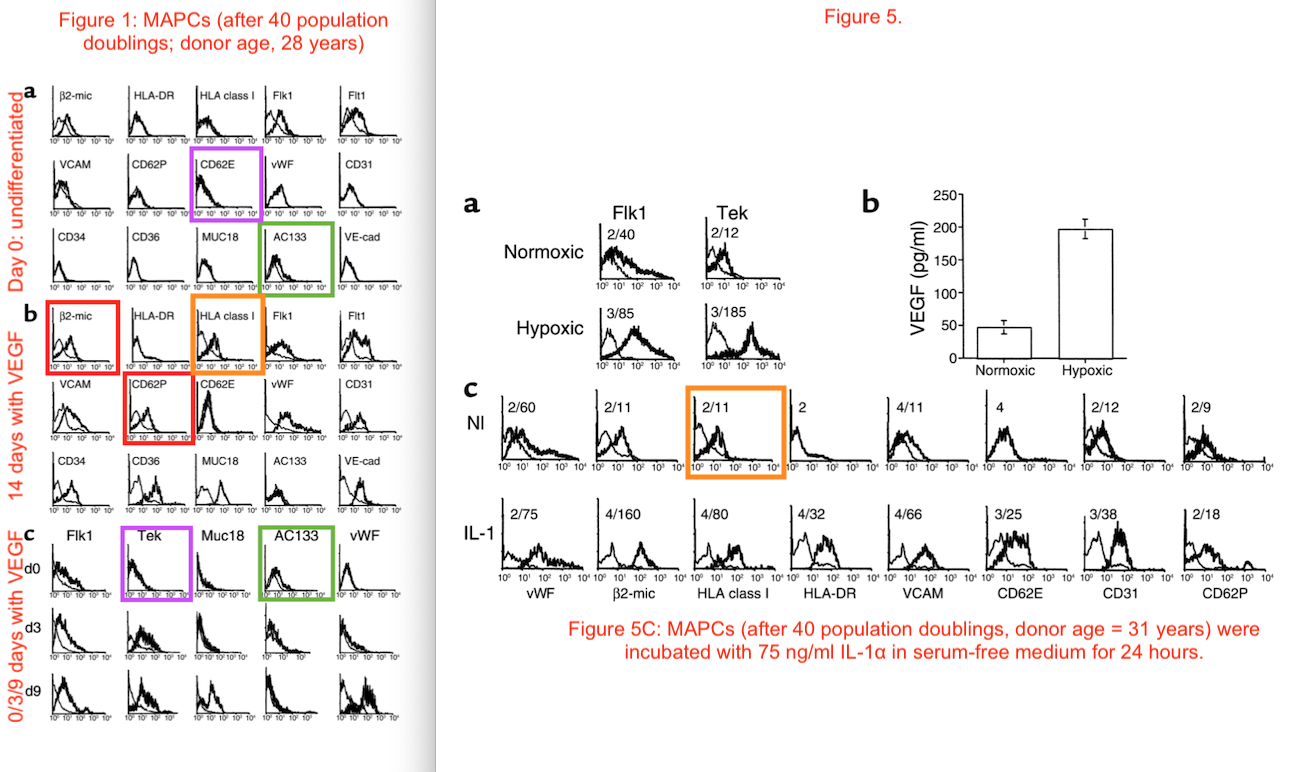
Another two corrections of a figure shared between two papers were explained by Bik here:
Y. Jiang , R. C. H. Zhao, C. M. Verfaillie Abnormal integrin-mediated regulation of chronic myelogenous leukemia CD34+ cell proliferation: BCR/ABL up-regulates the cyclin-dependent kinase inhibitor, p27Kip, which is relocated to the cell cytoplasm and incapable of regulating cdk2 activity Proceedings of the National Academy of Sciences (2000) – doi: 10.1073/pnas.190104497
That paper was corrected in April 2009, where the authors declared to have “inadvertently inserted the Western blot from a different experiment (Western blot for Cdk2, following immunoprecipitation of Cdk2 from a different experiment), instead of the correct Western blot for Cdk4, following immunoprecipitation of Cdk4 for the study described in Fig. 3“
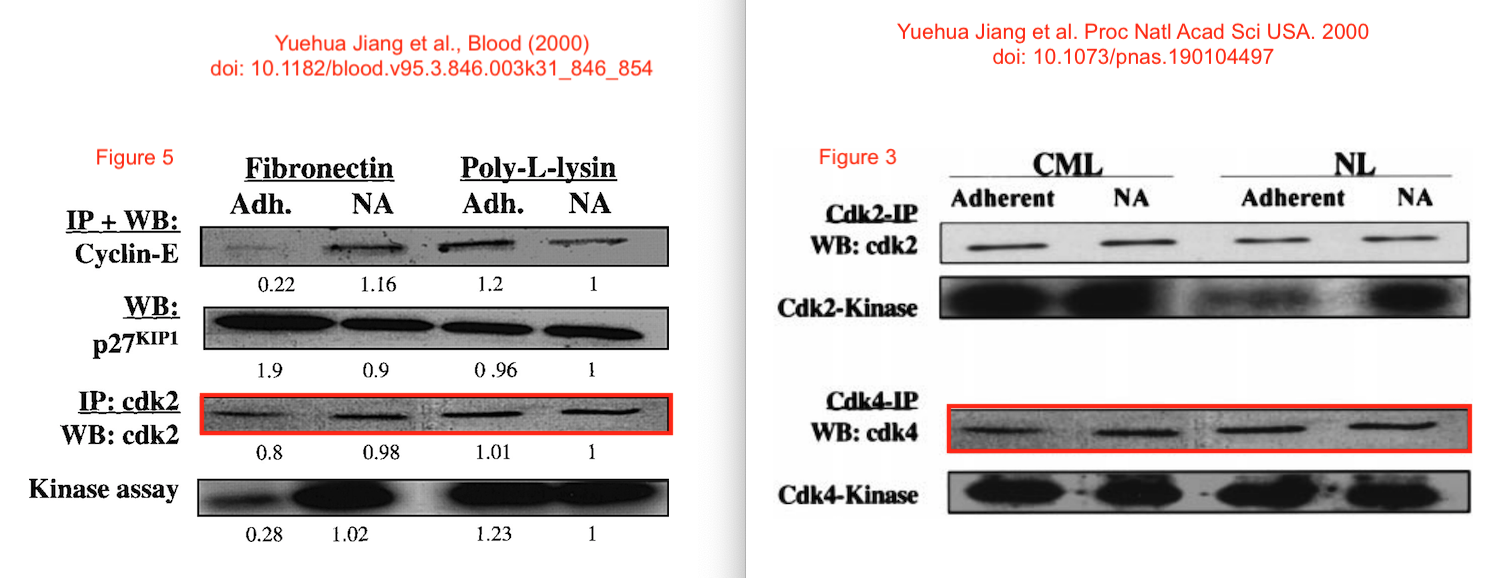
As Bik found out, the panel arrived not from some obscure long-lost experiment, but from another Verfaillie paper published in parallel: Jiang et al. Blood 2000, which was corrected in August 2009.
Y Jiang, F Prosper, CM Verfaillie Opposing effects of engagement of integrins and stimulation of cytokine receptors on cell cycle progression of normal human hematopoietic progenitors Blood (2000) doi: 10.1182/blood.v95.3.846.003k31_846_854
It turned out that neither the cdk4 blot in PNAS not cdk2 blot in Blood ever existed as presented. The authors provided replacement for both, and were made to clearly indicate previously underhand gel splicing:
“a validated Cdk2-IP/WB gel was located and has now been used to replace the row in question. In addition, black lines have been added to the row showing the IP + WB for cyclin E and the row showing the kinase assay, per Blood’s current policies, to indicate that blank lanes were spliced out. The authors removed the quantification under the lanes and revised the figure legend…”
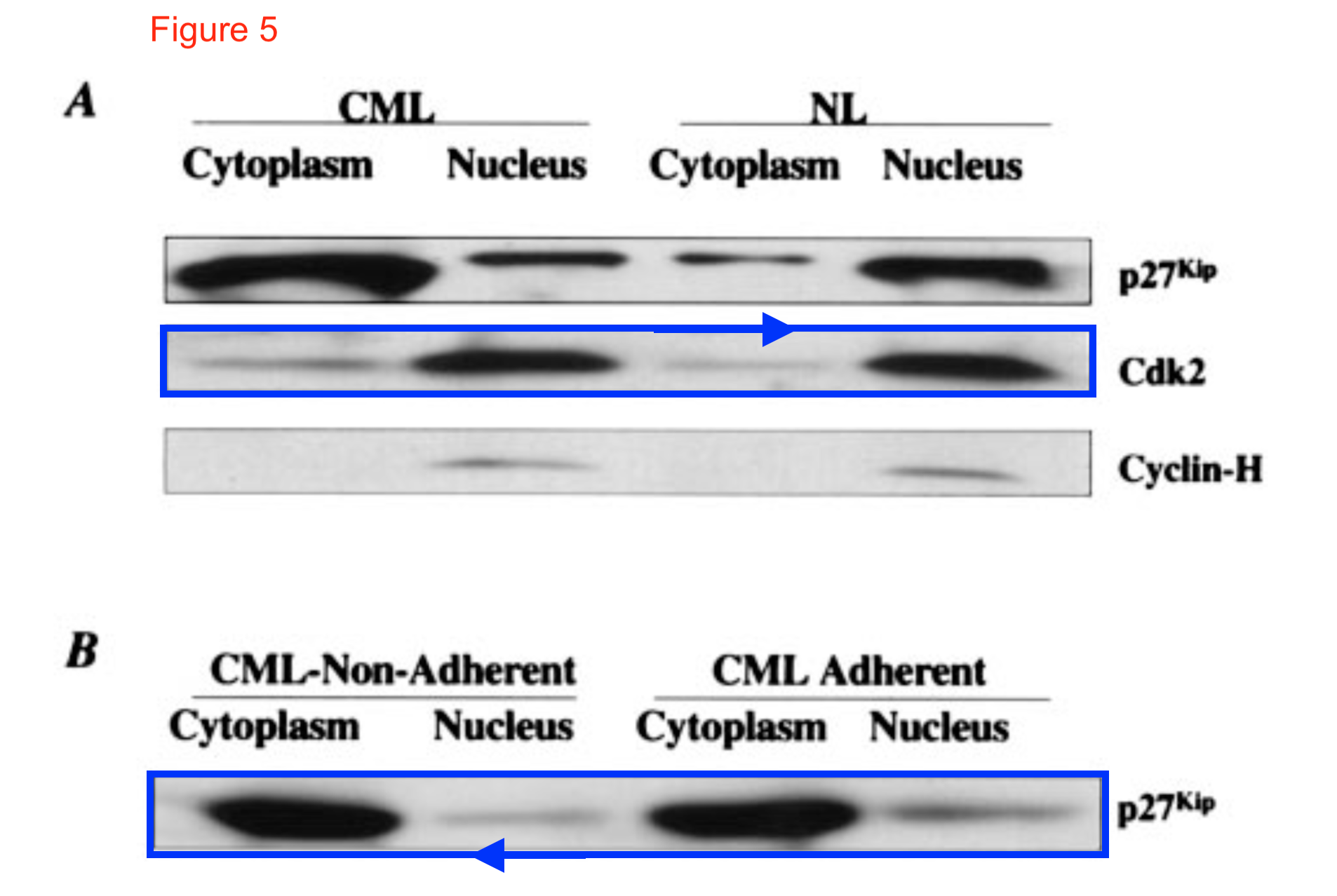
The PNAS paper contained another issue, which was reported by some whistleblower(s) to New Scientist, but which evaded correction. Bik highlights it now on PubPeer, with “blue boxes marking similarity between de Cdk2 panel in Figure 5A and the p27KIP panel, if one of the two panels is rotated 180 degrees and stretched a bit“.
It was very wise of University of Minnesota not to have screened Verfaillie’s papers properly (presumably they just acted on the concrete evidence of a long-sacked whistleblower). This is namely the kind of science with which Verfaillie’s career as director of the Stem Cell Institute at University of Minnesota took off:
R C Zhao, R S McIvor, J D Griffin, C M Verfaillie Gene therapy for chronic myelogenous leukemia (CML): a retroviral vector that renders hematopoietic progenitors methotrexate-resistant and CML progenitors functionally normal and nontumorigenic in vivo Blood (1997) 15;90(12):4687-98
Would you like to know how Minnesota professor Verfaillie announced to cure leukaemia? Hold on to your seat.
This is a truly some cock-sure handiwork of data forgery, a wanton debauchery of gel band cloning, probably done with scissors and glue, years before Photoshop became the standard tool. If only Verfaillie’s science was exposed back then, over 20 years ago – that disastrous Nature paper would not have happened.
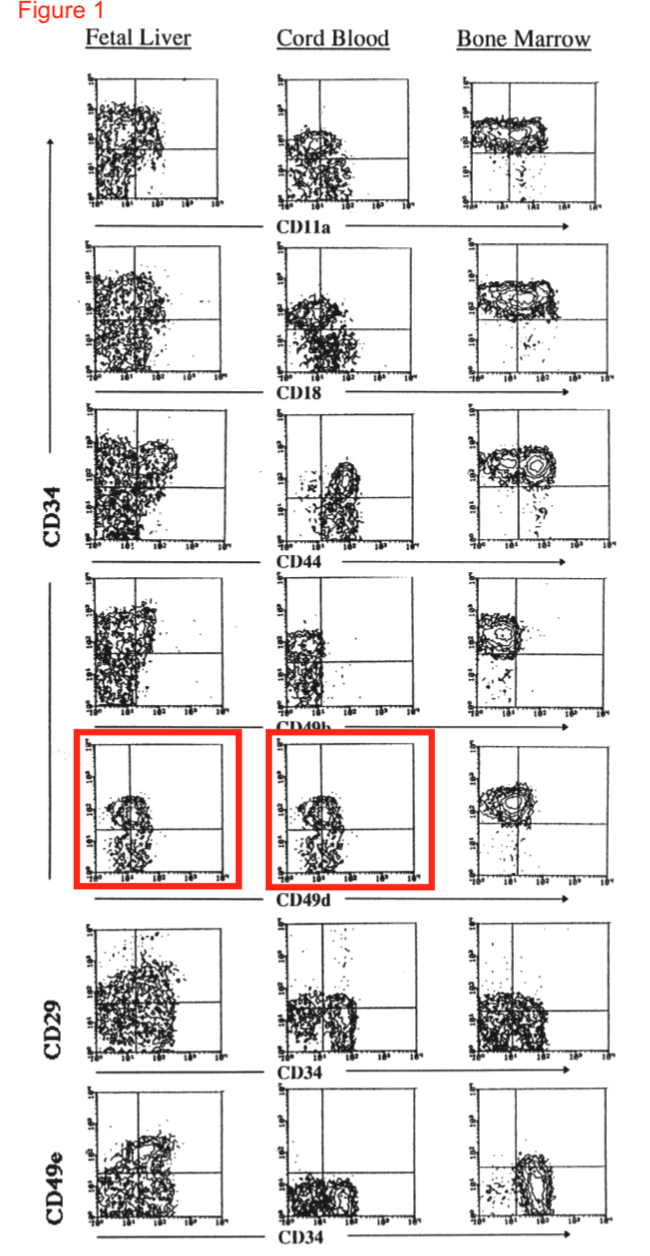
The following flow cytometry duplication does not seem like an innocent mistake of oversight anymore:
V Roy, CM Verfaillie Expression and function of cell adhesion molecules on fetal liver, cord blood and bone marrow hematopoietic progenitors: implications for anatomical localization and developmental stage specific regulation of hematopoiesis Experimental Hematology (1999) -doi: 10.1016/s0301-472x(98)00031-9
The next case does not look like a mistake at all. Even if once might accidentally reuse a flow cytometry plot, how can one accidentally calculate slightly different numbers from it? Unless, that was done intentionally, to make the two plots look different:
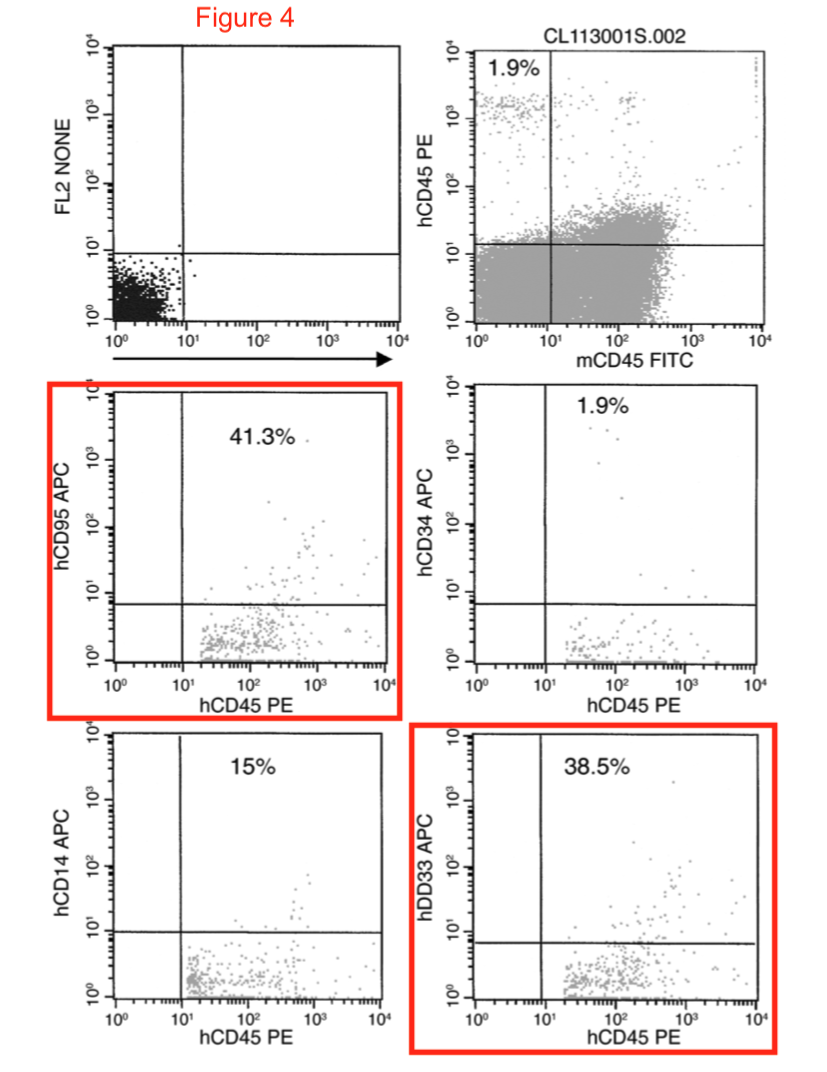
CED Lamming, L Augustin, M Blackstad, TC Lund, RP Hebbel, CM Verfaillie Spontaneous circulation of myeloid-lymphoid–initiating cells and SCID-repopulating cells in sickle cell crisis Journal of Clinical Investigation (2003)
doi: 10.1172/jci200315956
Update 6.12.2019. Bik now found another Verfaillie coauthored paper with serious issues. This time, the authors appealed to kidney failure patients on dialysis: a regenerative medicine cure is possible, with just a little bit of Photoshop.
S Gupta, C Verfaillie, D Chmielewski, Y Kim, ME Rosenberg A role for extrarenal cells in the regeneration following acute renal failure Kidney international (2002) doi: 10.1111/j.1523-1755.2002.kid569.x
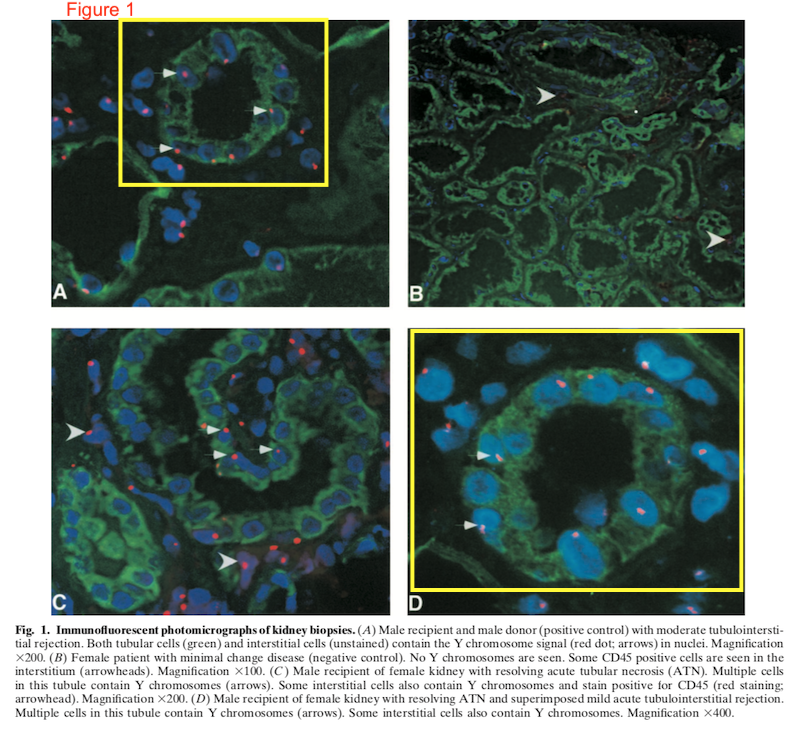
The Verfaillie scandal exploded in around mid 2000s, it included misconduct investigations by University of Minnesota, and ended with two retractions and some embarrassing corrections. In the middle of that, Verfaillie moved back to Belgium in 2005. By 2010, everyone moved on, the scientific community forgave Verfaillie and showered her and her SCIL with public funding. But the shenanigans continued, as Bik now uncovered.
MB Sahin, RE Schwartz, SM Buckley, Y Heremans, L Chase, WS Hu, CM Verfaillie Isolation and characterization of a novel population of progenitor cells from unmanipulated rat liver Liver Transplantation (2008) doi: 10.1002/lt.21380

Maybe the rat liver was “unmanipulated”, but the data in this paper is a different story. It definitely does not look like an accident or mistake of oversight. Same field of cells was rotated and cropped in two different ways to stand in for two different antibody stainings. And it happened already at KU Leuven, after the scandal in Minnesota.
This collaborative paper was also made with Verfaillie’s KU Leuven affiliation:
M Luo, Z Liu, H Hao, T Lu, M Chen, M Lei, CM Verfaillie, Z Liu High glucose facilitates cell cycle arrest of rat bone marrow multipotent adult progenitor cells through transforming growth factor-β1 and extracellular signal-regulated kinase 1/2 signalling without changing Oct4 expression Clinical and Experimental Pharmacology and Physiology (2012) doi: 10.1111/j.1440-1681.2012.05747.x
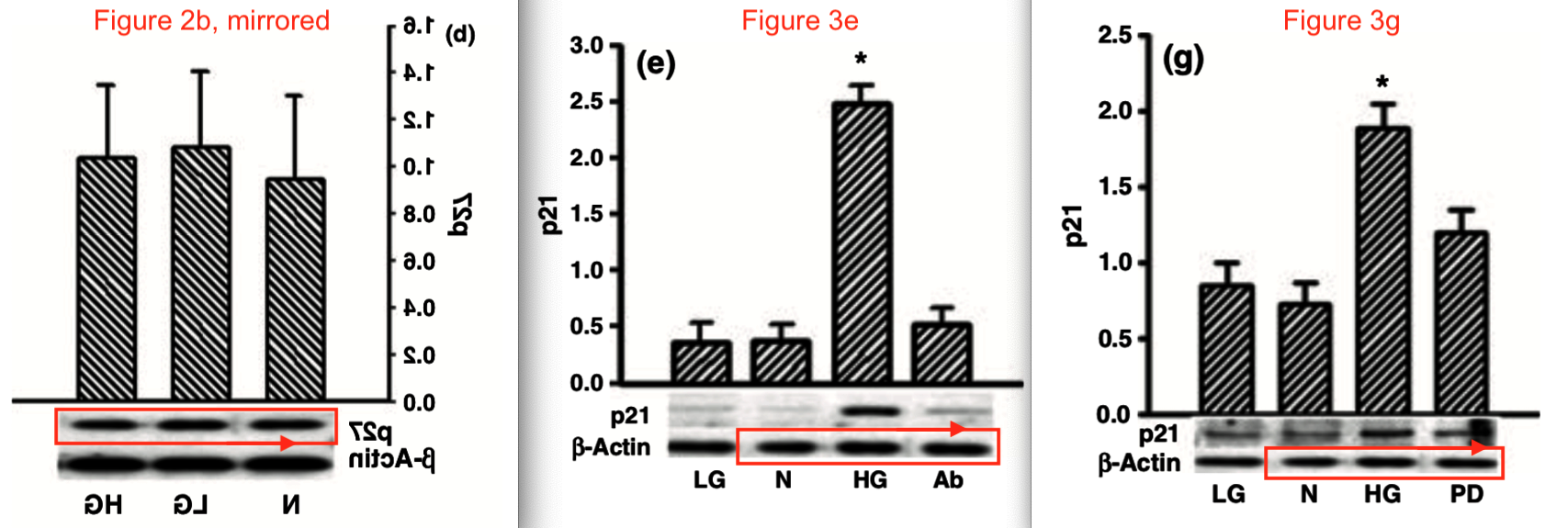
There are even worse collaborative Photoshop jobs, with Verfaillie’s name on them: Kwan et al 2006, Lu et al 2010, or this Verfaillie co-production with the Radboud University Nijmegen Medical Centre in Netherlands, Huls et al 2010:

Actually that Photoshop art is too fancy for Verfaillie’s lab. Her KU Leuven lab issued in 2013 this simple and traditional image fabrication, the good old shifted picture motif:
Y Li, K Eggermont, V Vanslembrouck, CM Verfaillie NKX2-1 activation by SMAD2 signaling after definitive endoderm differentiation in human embryonic stem cell Stem Cells and Development (2013) doi: 10.1089/scd.2012.0620
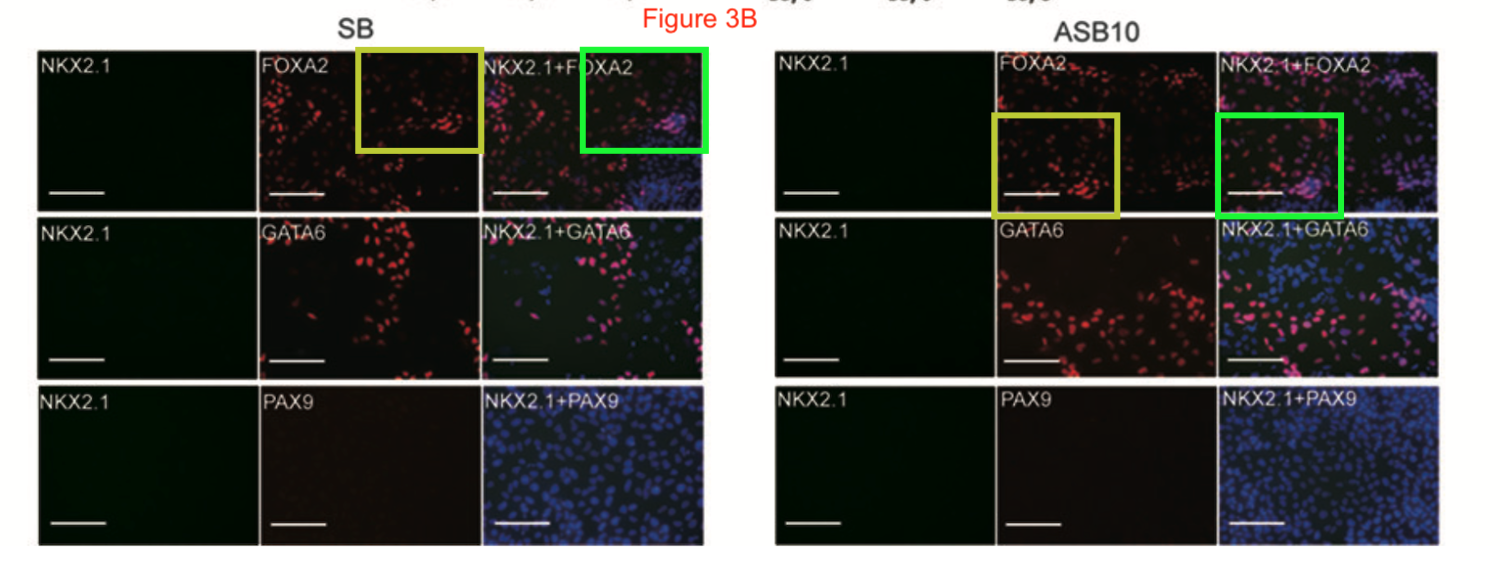
The most recent Verfaillie paper Bik reported on PubPeer is this, from 2014. So far, “just” one cloned gel band.
K Vanuytsel, Q Cai, N Nair, S Khurana, S Shetty, JR Vermeesch, L Ordovas, CM Verfaillie FANCA knockout in human embryonic stem cells causes a severe growth disadvantage Stem Cell Research (2014) doi: 10.1016/j.scr.2014.07.005
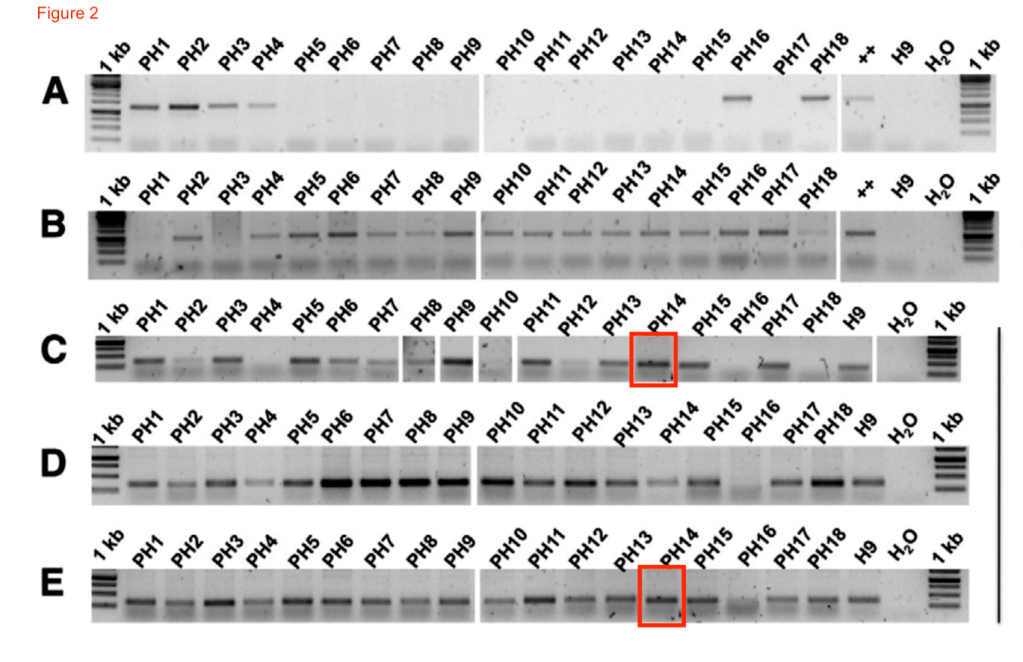
Verfaillie is 62 now, presumably KU Leuven would like her to retire in piece soon, and close the chapter. But of course Verfaillie will not leave her SCIL institute to some Tom, Dick or Harry when she retires. She namely installed Maurillo Sampaolesi as her second-in-command at SCIL. And Sampaolesi has extensive Photoshop experience, as his PubPeer record certifies. Look at this for example, Cassano et al PLOS One 2008, published by Sampaolesi’s new lab at SCIL:
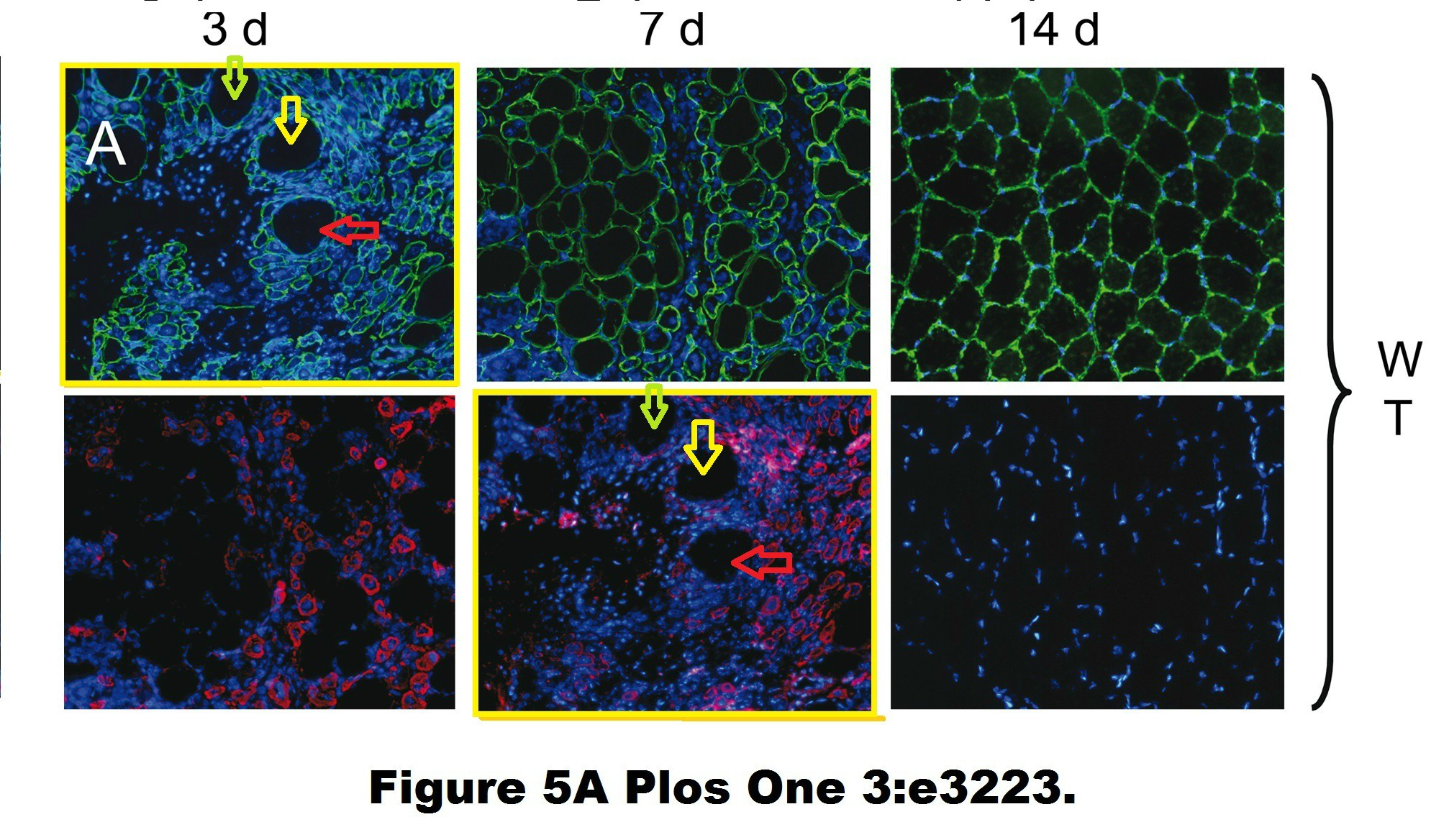
This is why Sampaolesi is the perfect successor for Verfaillie: he published in all the big journals, with the help of some Photoshop. The example of the disassembled Figure 2B in Sampaolesi et al Science 2003 shows his skills:
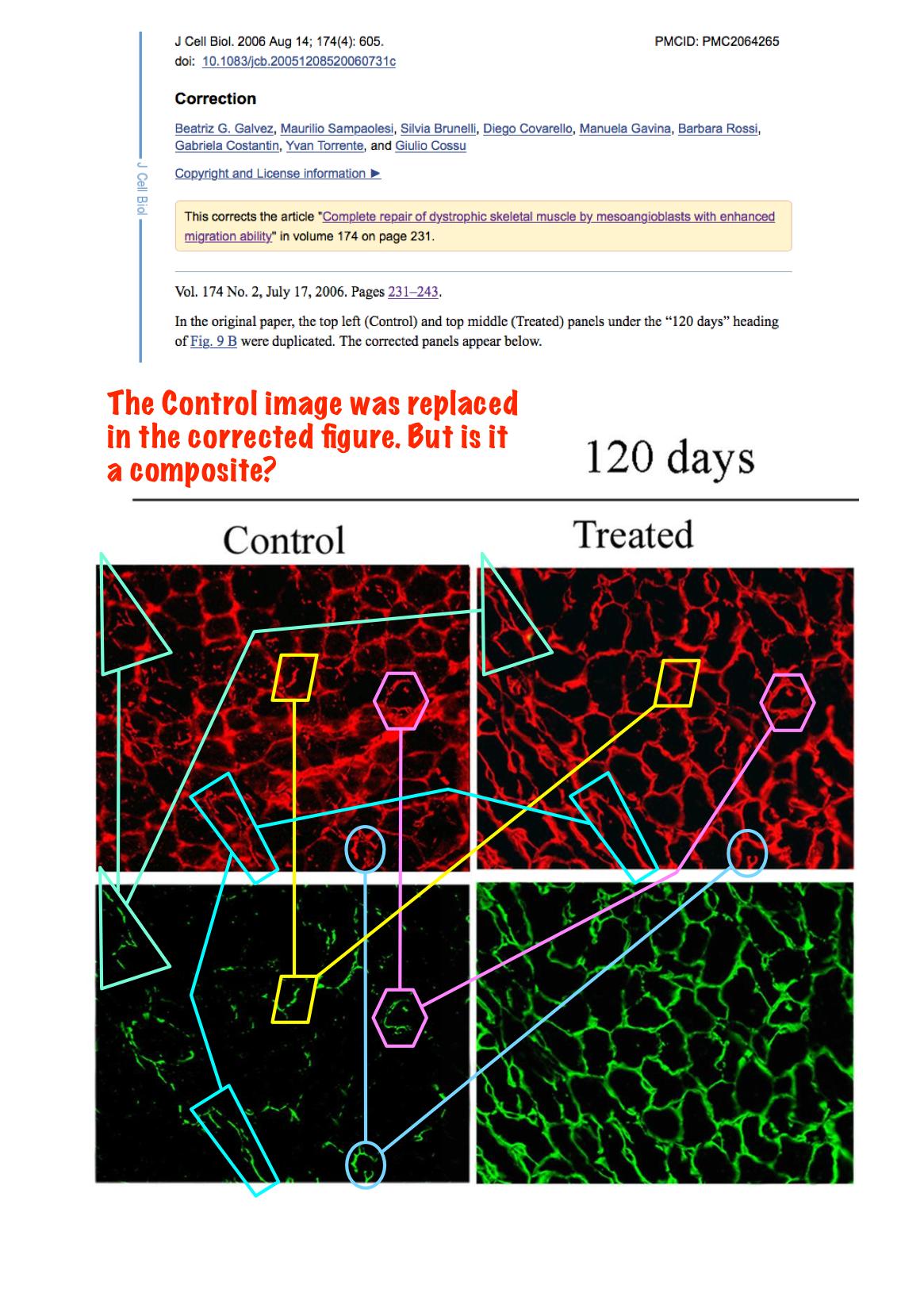
The elite journal Science did exactly nothing about that, not a thing. In a different case, the Journal of Cellular Biology accepted a forged correction from Sampaolesi and Cossu, for Galvez et al 2006. Look at the PubPeer discussion, and the illustration on the right.
Would you like to know why the journals behaved so meekly? Sampaolesi’s mentor and last author Giulio Cossu was namely investigated and whitewashed by his then-employer UCL in 2013, including for this paper. Cossu paid back his gratitude by lead-authoring in 2017 a white paper in The Lancet, where he, together with the UCL trachea transplanters Martin Birchall and Paolo De Coppi declared that Macchiarini’s technology works while calling for more human experimenting.
Full circle for the magic bone marrow of Catherine Verfaillie.
The article was updated on 6.12.2019
Update 27.01.2020
A reader pointed me to these papers:
M Delforge , MA. Boogaerts , PB. McGlave , CM. Verfaillie BCR/ABL− CD34+HLA-DR−Progenitor Cells in Early Chronic Phase, But Not in More Advanced Phases, of Chronic Myelogenous Leukemia Are Polyclonal Blood (1999) doi: 10.1182/blood.v93.1.284
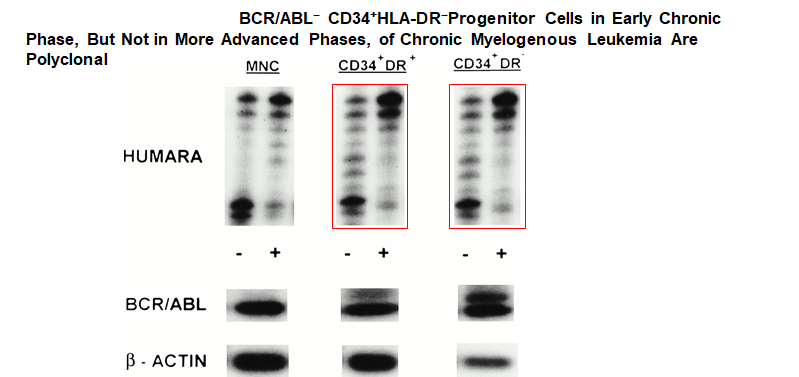
In another case, it seems the publisher BioMedCentral (BMC, owned by Springer Nature) issued a silent correction:
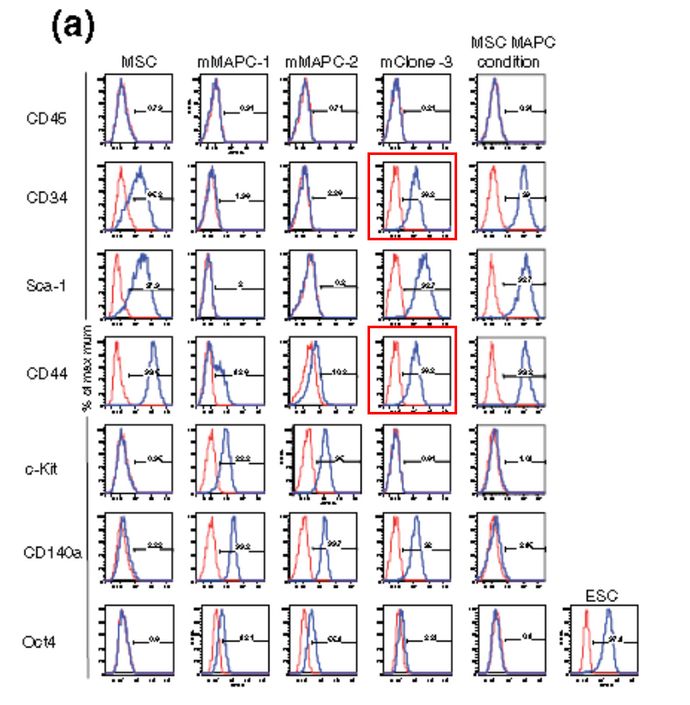
F Ulloa-Montoya , BL Kidder , KA Pauwelyn , G Chase , A Luttun , A Crabbe , M Geraerts , AA Sharov , Y Piao , MSH Ko , WS Hu , CM Verfaillie Comparative transcriptome analysis of embryonic and adult stem cells with extended and limited differentiation capacity Genome Biology (2007) doi: 10.1186/gb-2007-8-8-r163
The duplication is clearly present in the version initially deposited by the publisher BMC at NCBI PMC (PubMed). However, the online version at BMC itself shows a different plot for the sample mClone-3 CD44. No correction was announced.
Meanwhile, KU Leuven opened a misconduct investigation into Verfaillie affair. The research integrity manager Inge Lerouge offered to keep me updated, provided I sign a legally binding Non-Disclosure Agreement (NDA) which would prevent me from reporting, sharing or discussing any of that information for all eternity. Lerouge explained:
“both the respondent and the notifying party are subject to strict confidentiality and this obligation remains applicable after the closure of the entire CRI procedure and even after eventual public statements by the KU Leuven about it (see sub 4).
- The possibility exists that the Rector (or his delegate) decides to make a public statement, he being, according to article 9 of the CRI Procedure, the only person responsible for external communication about CRI cases. Although we cannot at this stage predict the future nor guarantee that such public statements will be made, we can agree that, if they are, you will be duly alerted. The information included in public statements by the Rector is by its nature not covered by confidentiality obligations.“
I refused to sign the NDA, since it would allow KU Leuven to control my reporting with legal threats.
Update 16.07.2020
KU Leuven now completed the investigation and issued a press release, which was reported by Belgian newspapers. I was not notified, only learned of it from Twitter follower. TL;DR: Only KU Leuven period papers were analysed, Verfaillie is innocent, someone else did it, conclusions not affected, Schneider (though unnamed) is slanderous scum.
“No breach
In accordance with the applicable regulations, the CRI examined four recent publications. Other universities have examined those publications for which they were competent.
From the investigation conducted by the Leuven Commission and the confirmation thereof by the external expert, it is apparent that there was no breach of research integrity in the publications investigated. It is true that a limited number of figures contained an inaccuracy that is not in line with the high standards that are rightly set for scientific figures. Nevertheless, a thorough study of all aspects of the case has shown that these figures were composed in good faith and that there can be no question of an infringement of research integrity.
Professor Catherine Verfaillie was explicitly mentioned in the media as co-author of the publications and supervisor of the researchers concerned. She had already rectified problems that she had noticed in the publications under investigation before any mention was made of them. She was not aware of the other problems until the time of the complaint. The CRI also points to the efficiency of the quality assurance system used by Professor Verfaillie. Thanks to this system, the investigation committee had access to all the raw data of the publications concerned and the experiments could be checked in detail. The investigation showed that there was no intention to misrepresent results.
On the basis of these findings, the CRI has concluded that Professor Verfaillie cannot be blamed for any breach of research integrity. “
KU Leuven Rector Luc Sells than lashed out in the press release at journalists like Schneider, without naming anyone:
“We therefore want to protect our researchers against gratuitous reports or complaints via public forums even before an investigation could be carried out. There is an essential difference between expressing a suspicion and openly naming and shaming.”
Update 19.05.2023
A Rectification to this article was published here, after the former science journalist and now lawyer Eugenie Reich took issue with the mention of “whistleblowers” above.
I thank all my donors for supporting my journalism. You can be one of them!
Make a one-time donation:
I thank all my donors for supporting my journalism. You can be one of them!
Make a monthly donation:
Choose an amount
Or enter a custom amount
Your contribution is appreciated.
Your contribution is appreciated.
DonateDonate monthly


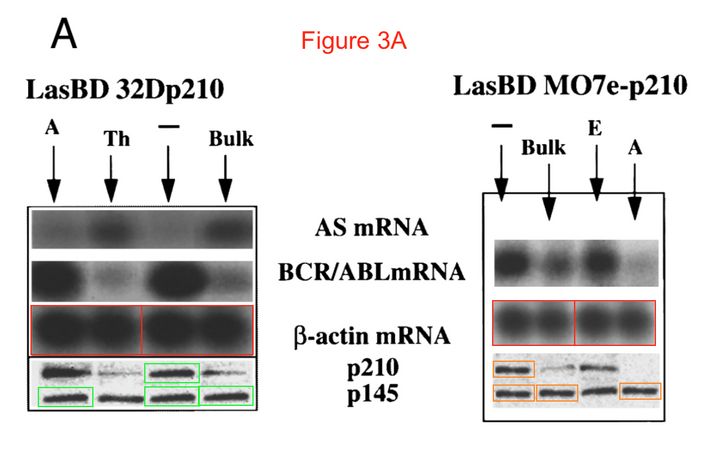
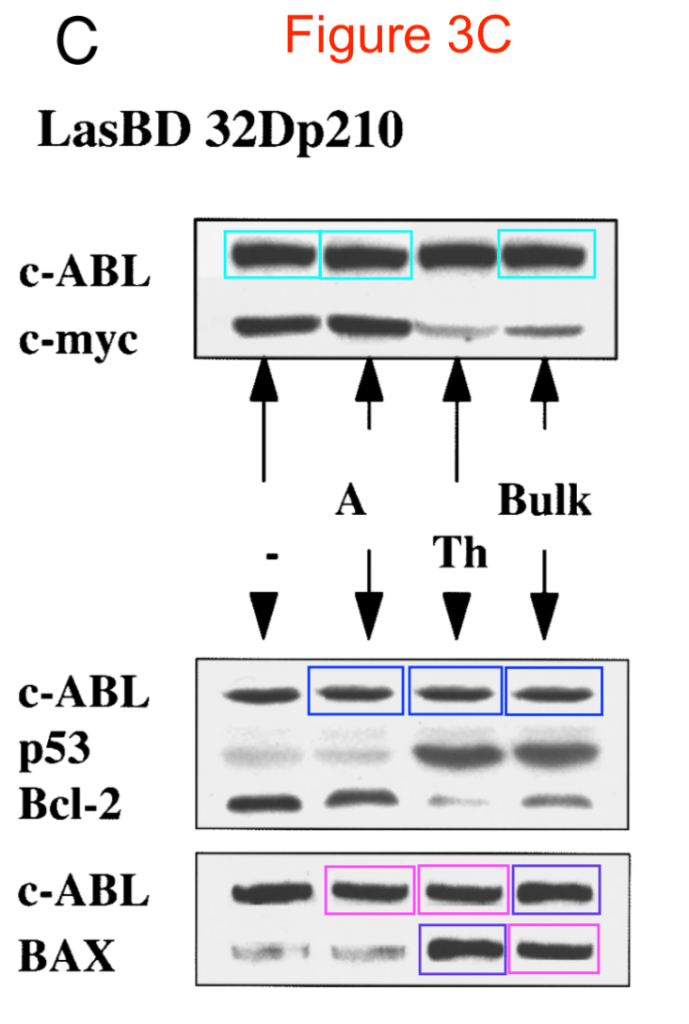
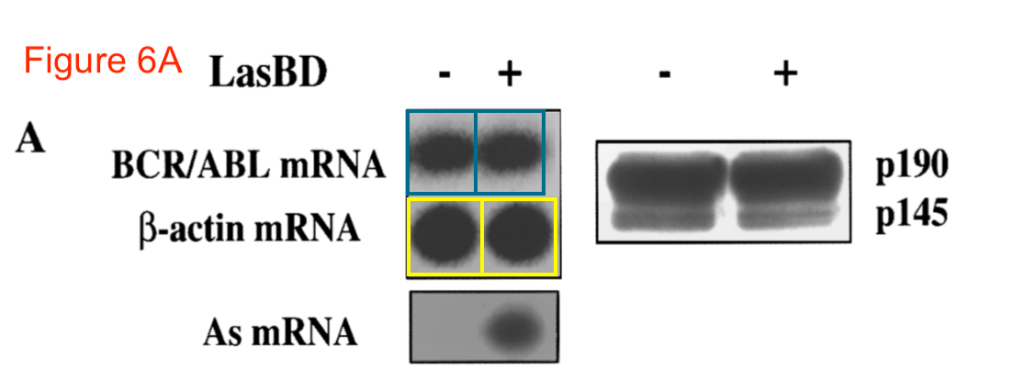
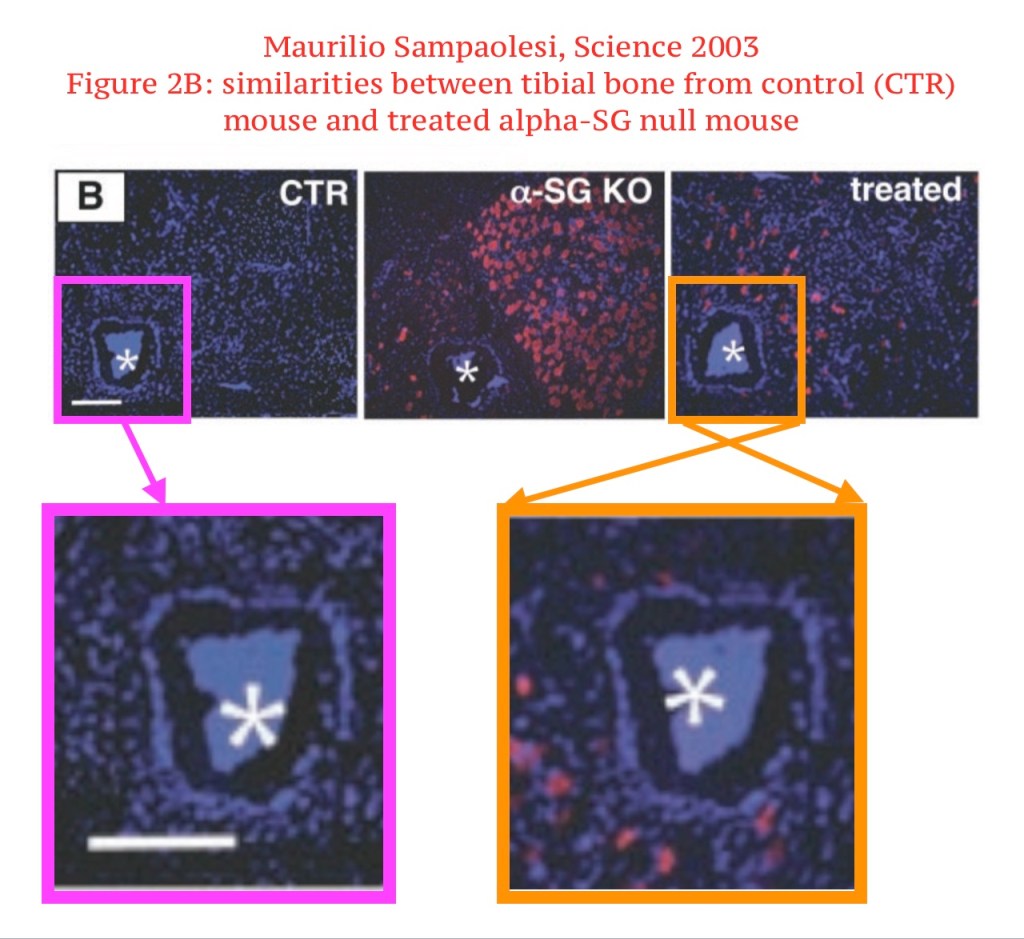
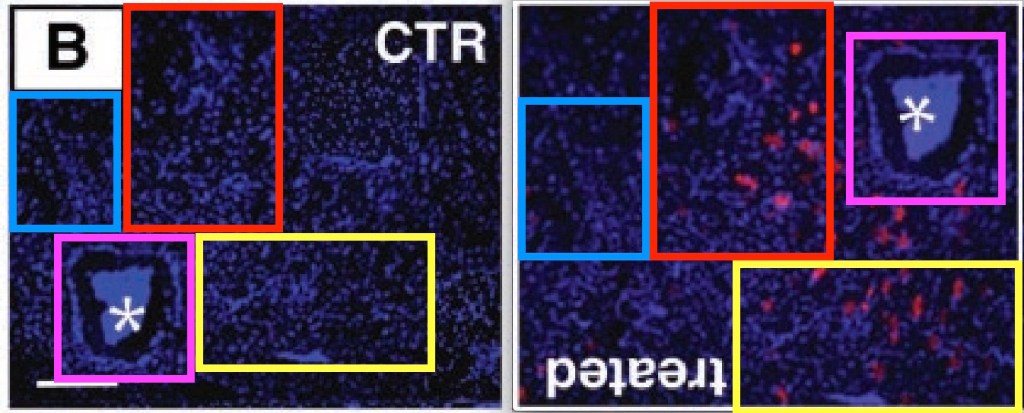

Not a surprise.
Right now I am under a lot of pressure. My lab head yelled at me “I want a paper out by Thanksgiving!” He really said this, and repeatidly. Fortunately we (or should I say I) have something interesting to publish.
The data is intrinsically interesting (I got lucky) so I don’t really feel any pressure to cheat.
But if a “famous person” was yelling at you and your data was of questionable statistical significance, and you were on a visa, I could see why you might buckle and “produce”.
Leonid, did you like dinosours as a kid? You cartoon teeth look like they belong on a T Rex (growl!).
LikeLike
We had no dinosaur toys in the Soviet Union. Just plastic soldiers. I once was a given a toy nuclear missile launcher.
LikeLike
Cool! Was the ballistic missile model (ICBM, say SS-21) just an empty canister? Ha-ha. “We will bury you!” 🙂
LikeLike
“Sampaolesi’s mentor and last author Giulio Cossu..”
2013 retraction.
J Cell Biol. 2006 Jan 16;172(2):233-44. Epub 2006 Jan 9.
Follistatin induction by nitric oxide through cyclic GMP: a tightly regulated signaling pathway that controls myoblast fusion.
Pisconti A1, Brunelli S, Di Padova M, De Palma C, Deponti D, Baesso S, Sartorelli V, Cossu G, Clementi E.
Author information
1
Stem Cell Research Institute, Hospital San Raffaele, 20132 Milan, Italy.
2013 retraction.
http://jcb.rupress.org/content/200/3/359
After concerns were raised by a reader, the Editors of The Journal of Cell Biology detected the following issues with the data in the above article:
(1) The top panel in Fig. 1 F (NOS-1μ) is identical to the top panel in Fig. 2 B (α-sGC).
(2) The bottom panel in Fig. 1 F (NOS-III) is identical to the bottom panel in Fig. 2 B (GAPDH).
(3) Lanes 2 and 3 of the Follistatin panel for satellite cells in Fig. 4 A are identical to lanes 1 and 2 of the Myostatin panel for satellite cells in the same figure.
(4) A band appears to have been erased from lane 4 of the Follistatin panel for satellite cells in Fig. 4 A.
(5) Lane 4 of the Myostatin panel for satellite cells in Fig. 4 A is identical to lane 1 of the Follistatin panel for E12.5/E15.5 in the same figure.
(6) The E9.5 explants and E12.5/E15.5 panels for GAPDH in Fig. 4 A are identical.
Given the above issues with the experimental data in Fig. 4 A, the quantification data in Fig. S1 A cannot be validated.
No issues were detected with the other figures in the paper nor with the other parts of the figures listed above (Fig. 1, A–E, G, and H; Fig. 2, A and C–E; Fig. 4 B; and Fig. S1 B).
The authors were contacted by the Executive Editor of the journal and provided the following statement:
“Given the time that has elapsed since the original date of publication, we are unable to find the original data used to prepare these figures and are not able to explain these observations. We thus retract the paper and apologize for any confusion it may have caused to the research community. Because of the issues noted above, the conclusions presented in this paper that changes in NOS activity are the consequence of activation and inhibition of enzyme activity and not of changes in protein expression (Fig. 1 F), that regulation of guanylate cyclase occurs through posttranslational events (Fig. 2 B), that there is a role for nitric oxide in expression of follistatin mRNA in cultured cells (Figs. 4 A and S1 A), and that there are roles for nitric oxide and cGMP in expression of follistatin mRNA in vivo (Figs. 4 A and S1 A) cannot be validated. The reported observations on the effects of nitric oxide and cGMP on myoblast fusion in cultured cells, of cGMP on myogenesis in vivo, of cGMP on expression of follistatin mRNA in cultured cells, of cGMP and nitric oxide on expression of follistatin protein in cultured cells, and of cGMP on expression of follistatin protein in vivo are not affected by the flaws detected in the figures.”
As a result of this retraction, no data in this paper should be cited in the scientific literature.
The Authors and Editors have informed the University of Milan of this retraction.
https://retractionwatch.com/2013/01/22/clare-francis-scores-a-bullseye-journal-of-cell-biology-paper-retracted-for-image-manipulation/
LikeLike
Pity, since in the 2000s I was impressed by the bone marrow progenitors which can differentiate into any somatic cell. My heroes were stem cell researchers, and all that has vanished. Of note, the decay of stem cell science started very early after the first wave of “big papers”, and I wonder why does this agony last a decade now.
LikeLike
Hey, circulating cells can still build you a new hematopoietic system, that ain’t bad.
LikeLike
https://www.standaard.be/cnt/dmf20191205_04752777
LikeLike
https://www.tijd.be/politiek-economie/belgie/vlaanderen/ku-leuven-onderzoekt-papers-stamcelspecialisten-op-vervalsing/10188404.html?rc_source=tijd&rc_medium=unknown&rc_content=newsticker
LikeLike
Oh dear. They already decided to ignore everything which happened before Verfaillie moved to KU Leuven.
LikeLike
http://www.scholarswalk.umn.edu/discovery/catherine.html
“The Magic Seeds
By Chris Coughlan-Smith, orignally published in the January-February 2002 issue of Minnesota magazine.”
© 2010 Regents of the University of Minnesota. All rights reserved.
The University of Minnesota is an equal opportunity educator and employer
Last modified on October 28, 2010
2009.
Directed differentiation of mouse cochlear neural progenitors in vitro.
Lin J, Feng L, Hamajima Y, Komori M, Burns TC, Fukudome S, Anderson J, Wang D, Verfaillie CM, Low WC.
Am J Physiol Cell Physiol. 2009 Mar;296(3):C441-52. doi: 10.1152/ajpcell.00324.2008. Epub 2008 Dec 17. Retraction in: Am J Physiol Cell Physiol. 2009 Dec;297(6):C1596.
PMID: 19261910
Purification and ex vivo expansion of postnatal human marrow mesodermal progenitor cells.
Reyes M, Lund T, Lenvik T, Aguiar D, Koodie L, Verfaillie CM.
Blood. 2001 Nov 1;98(9):2615-25. Retraction in: Blood. 2009 Mar 5;113(10):2370.
PMID: 11675329
LikeLike
With power many things can be achieved. But it may end badly, shown by the lesson from Elena Ceausescu: https://www.stuff.co.nz/science/94679348/roger-hanson-elena-ceausescu–romanian-dictators-wife-and-fake-scientist
Btw, Research Gate has created a profile to Elena Ceausescu. No clue from where they have did dig up those publications , and whether they find it ethical to parade these fake and plagiarized works. (link: ELENA CEAUŞESCU’s scientific contributions, on http://www.researchgate.com). For the young generation: she was the wife of the Romanian communist dictator Nikolai Ceausescu, she had a fake scientific career, and she was executed by a firing squad in 1989.
LikeLike
Pingback: Concern about stem cell research from KU Leuven and the University of Minnesota – Science Integrity Digest
https://www.brusselstimes.com/all-news/belgium-all-news/82253/kuleuven-investigates-claims-against-world-authority-on-stem-cell-research/
LikeLike
https://www.brusselstimes.com/all-news/belgium-all-news/82253/kuleuven-investigates-claims-against-world-authority-on-stem-cell-research/
“In the meantime, Rector Sels stressed that there will be no rush to judgement.
“I want to stress that we continue to have every trust in the researchers concerned, as long as the outcome of the procedure remains unknown,” he told De Tijd. “Above all, this is about the scientific accuracy of the articles, not about nailing individuals to the cross. The name of Catherine Verfaillie is now being brought forward prominently, but several authors worked on the papers. Even if mistakes are shown, it remains to be seen who exactly is responsible.””
The Rector needs to move swiftly. Although it is now trendy to argue about what doctors should do to their patients “first do no net harm” is not a bad place to start with.
LikeLike
I worked with Verfaillie for a couple of months before deciding that we are not a good fit. She was always confused when you ask her something about lab work or physiology. My honest opinion is that she wasn’t smart enough to do actual photoshopping of results. And I never experienced or heard that she pressured people for papers. However, I do believe people used her name (and funding) to publish their research in much better journals than what they would normally do. It’s pretty obvious some of them cut corners (or outright fabricated results) to achieve this. She had hundreds of meetings and students per week, so the aspect of thoroughly checking results was always rather dubious.
LikeLike
“However, I do believe people used her name (and funding) to publish their research in much better journals than what they would normally do. It’s pretty obvious some of them cut corners (or outright fabricated results) to achieve this.”
Shedding the funding should put a stop to this.
LikeLike
Every advisor (I have had 4-5), no matter how intelligent I thought they were, was confused as to what I was doing in the lab, because they were not paying careful attention at all to what I was doing, at least until I was preparing a manuscript. I think most advisors simply do not care about data until it seems like they will get some kind of reward from it. Passive retardedness come to my mind.
LikeLike
Photoshop in research = Science
Banana taped to wall in Miami = Art
https://www.cnn.com/style/article/art-basel-miami-maurizio-cattelan-banana-scli-intl/index.html
LikeLike
https://journosdiary.com/2016/01/04/catherine-verfaillie-another-stem-cell-fraudster/
Strong words from The Hindu, but they are from 2008.
LikeLike
Ex Prof from Uni of Toronto , JLP Vasquez writes in
http://ronininstitute.org/the-rise-of-the-scientist-bureaucrat/3297/
“Now, principal investigators (PIs) have trainees and technicians doing all these things for them, whereas some PIs are so busy with administrative chores and searching for money to keep their laboratories going that barely step into their laboratory”
The book is available on Springer. You can get it online if library subscribes to springer.
https://www.springer.com/in/book/9783030123253
LikeLike
You may also like to read “The cancer of bureaucracy: how it will destroy science, medicine, education; and eventually everything else”.
https://www.ncbi.nlm.nih.gov/pubmed/20071103
LikeLike
I am originally from Belgium and can confirm that Verfaille is (hopefully soon was) the public face of biomedical science and a very well-known figure beyond the scientific community. We are talking about top 3 of most famous scientists to the general public. It is appalling that KULeuven, the Belgian scientific establishment and the EU gave her all this support after the USA case had emerged. These are not minor issues on some side projects, but pervasive tampering on her most important scientific “discoveries”.
LikeLike
“Crime pays” in contemporary sciences, particularly in biomedicine.
LikeLike
https://www.the-scientist.com/news-opinion/ku-leuven-investigates-whether-stem-cell-scientist-falsified-data-66835
LikeLike
Pingback: "La feccia" - Ocasapiens - Blog - Repubblica.it
This is quite embarassing, actually contacted her lab back in 2017 to do my master thesis but now I’m sort of relief I didn’t finally go on.
LikeLike
A Belgian newspaper announced that the university does not find her guilty of fraud. They do admit there were problems with images. Strange conclusion. The university informed that Verfaillie needs to implement an extra safety mechanism: every image needs to be given a “pasport” containing the history of the image. All papers with doubts have been corrected with the right images or a correction has been asked. The report (the one the KUL made about her) was also shown to an external specialist for verification and this expert agreed with the conclusions. Baseline here is: yes images were wrong, but nothing was down deliberately…. Oh boy…
LikeLike
Pingback: Operation Cytokine Storm – For Better Science